University of Maryland Research Log Project Part 2 - Week 2
VerifiedAdded on 2022/08/18
|8
|1573
|16
Homework Assignment
AI Summary
This assignment is a detailed response to the Research Log Project Part 2 for a course at the University of Maryland University College. The project guides the student through the research process, starting with a review of their research question and key concepts from Part 1. It then progresses through ...

Research Log Project Part 2 for
Jung Wu
Note: This project has not yet been saved.
Instructions: Work through each step of this log, answering each question as the directions
indicate. Step 1 is not graded. Steps 2 through 5 will each receive a grade, and the sum of these
grades will constitute your total grade for Research Log Project Part 2. Refer to the section on
how each step of the log will be graded for detailed grading information.
Step 1: Thinking Back to Research Log Project Part 1
A. Research Question
Record your research question from Research Project Log Part 1. Click on My Submissions in
Week 1 Content to review your submitted work and instructor feedback. (Step 1)
B.Key Concepts
Record your key concepts from Log Part 1. (Step 2)
C. Original Boolean Search Statement
Record your original search statement from Research Log Project Part 1. (Step 3)
How will Step 1 be graded?
Step 1 will not receive a grade.
How can mindfulness help children w ith
disabilities?
Mindfulness, Children, Disabilities
(mindfulness OR children OR disab**) AND
(Youth OR juvenile) AND
(disab** OR cerebral palsy OR
dow n syndrome OR adhd OR cystic fibrosis)
Jung Wu
Note: This project has not yet been saved.
Instructions: Work through each step of this log, answering each question as the directions
indicate. Step 1 is not graded. Steps 2 through 5 will each receive a grade, and the sum of these
grades will constitute your total grade for Research Log Project Part 2. Refer to the section on
how each step of the log will be graded for detailed grading information.
Step 1: Thinking Back to Research Log Project Part 1
A. Research Question
Record your research question from Research Project Log Part 1. Click on My Submissions in
Week 1 Content to review your submitted work and instructor feedback. (Step 1)
B.Key Concepts
Record your key concepts from Log Part 1. (Step 2)
C. Original Boolean Search Statement
Record your original search statement from Research Log Project Part 1. (Step 3)
How will Step 1 be graded?
Step 1 will not receive a grade.
How can mindfulness help children w ith
disabilities?
Mindfulness, Children, Disabilities
(mindfulness OR children OR disab**) AND
(Youth OR juvenile) AND
(disab** OR cerebral palsy OR
dow n syndrome OR adhd OR cystic fibrosis)
Paraphrase This Document
Need a fresh take? Get an instant paraphrase of this document with our AI Paraphraser
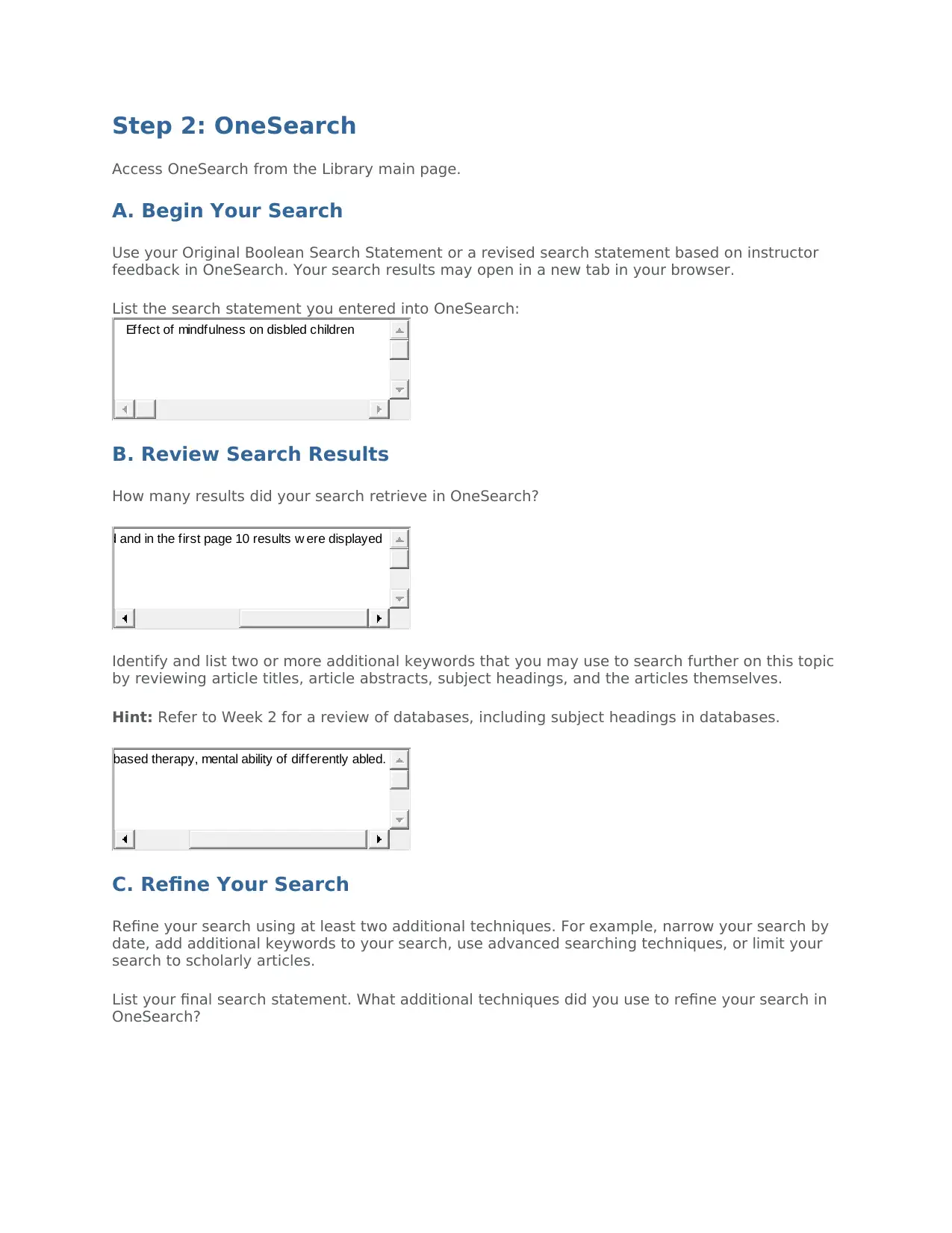
Step 2: OneSearch
Access OneSearch from the Library main page.
A. Begin Your Search
Use your Original Boolean Search Statement or a revised search statement based on instructor
feedback in OneSearch. Your search results may open in a new tab in your browser.
List the search statement you entered into OneSearch:
B. Review Search Results
How many results did your search retrieve in OneSearch?
Identify and list two or more additional keywords that you may use to search further on this topic
by reviewing article titles, article abstracts, subject headings, and the articles themselves.
Hint: Refer to Week 2 for a review of databases, including subject headings in databases.
C. Refine Your Search
Refine your search using at least two additional techniques. For example, narrow your search by
date, add additional keywords to your search, use advanced searching techniques, or limit your
search to scholarly articles.
List your final search statement. What additional techniques did you use to refine your search in
OneSearch?
Effect of mindfulness on disbled children
total w ere displayed and in the first page 10 results w ere displayed
mindfulnes-based therapy, mental ability of differently abled.
Access OneSearch from the Library main page.
A. Begin Your Search
Use your Original Boolean Search Statement or a revised search statement based on instructor
feedback in OneSearch. Your search results may open in a new tab in your browser.
List the search statement you entered into OneSearch:
B. Review Search Results
How many results did your search retrieve in OneSearch?
Identify and list two or more additional keywords that you may use to search further on this topic
by reviewing article titles, article abstracts, subject headings, and the articles themselves.
Hint: Refer to Week 2 for a review of databases, including subject headings in databases.
C. Refine Your Search
Refine your search using at least two additional techniques. For example, narrow your search by
date, add additional keywords to your search, use advanced searching techniques, or limit your
search to scholarly articles.
List your final search statement. What additional techniques did you use to refine your search in
OneSearch?
Effect of mindfulness on disbled children
total w ere displayed and in the first page 10 results w ere displayed
mindfulnes-based therapy, mental ability of differently abled.
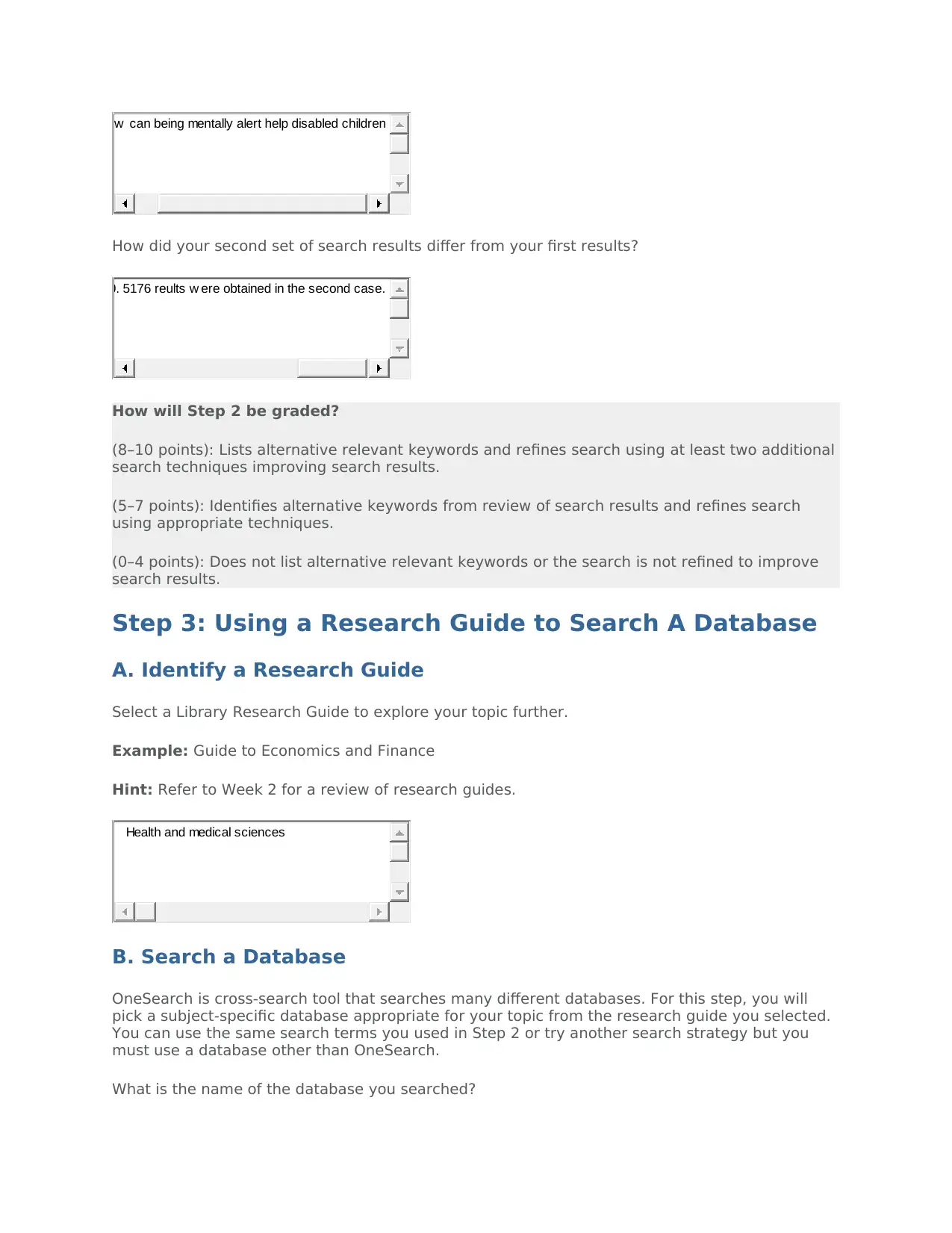
How did your second set of search results differ from your first results?
How will Step 2 be graded?
(8–10 points): Lists alternative relevant keywords and refines search using at least two additional
search techniques improving search results.
(5–7 points): Identifies alternative keywords from review of search results and refines search
using appropriate techniques.
(0–4 points): Does not list alternative relevant keywords or the search is not refined to improve
search results.
Step 3: Using a Research Guide to Search A Database
A. Identify a Research Guide
Select a Library Research Guide to explore your topic further.
Example: Guide to Economics and Finance
Hint: Refer to Week 2 for a review of research guides.
B. Search a Database
OneSearch is cross-search tool that searches many different databases. For this step, you will
pick a subject-specific database appropriate for your topic from the research guide you selected.
You can use the same search terms you used in Step 2 or try another search strategy but you
must use a database other than OneSearch.
What is the name of the database you searched?
How can being mentally alert help disabled children
g from the year 2020. 5176 reults w ere obtained in the second case.
Health and medical sciences
How will Step 2 be graded?
(8–10 points): Lists alternative relevant keywords and refines search using at least two additional
search techniques improving search results.
(5–7 points): Identifies alternative keywords from review of search results and refines search
using appropriate techniques.
(0–4 points): Does not list alternative relevant keywords or the search is not refined to improve
search results.
Step 3: Using a Research Guide to Search A Database
A. Identify a Research Guide
Select a Library Research Guide to explore your topic further.
Example: Guide to Economics and Finance
Hint: Refer to Week 2 for a review of research guides.
B. Search a Database
OneSearch is cross-search tool that searches many different databases. For this step, you will
pick a subject-specific database appropriate for your topic from the research guide you selected.
You can use the same search terms you used in Step 2 or try another search strategy but you
must use a database other than OneSearch.
What is the name of the database you searched?
How can being mentally alert help disabled children
g from the year 2020. 5176 reults w ere obtained in the second case.
Health and medical sciences
⊘ This is a preview!⊘
Do you want full access?
Subscribe today to unlock all pages.

Trusted by 1+ million students worldwide
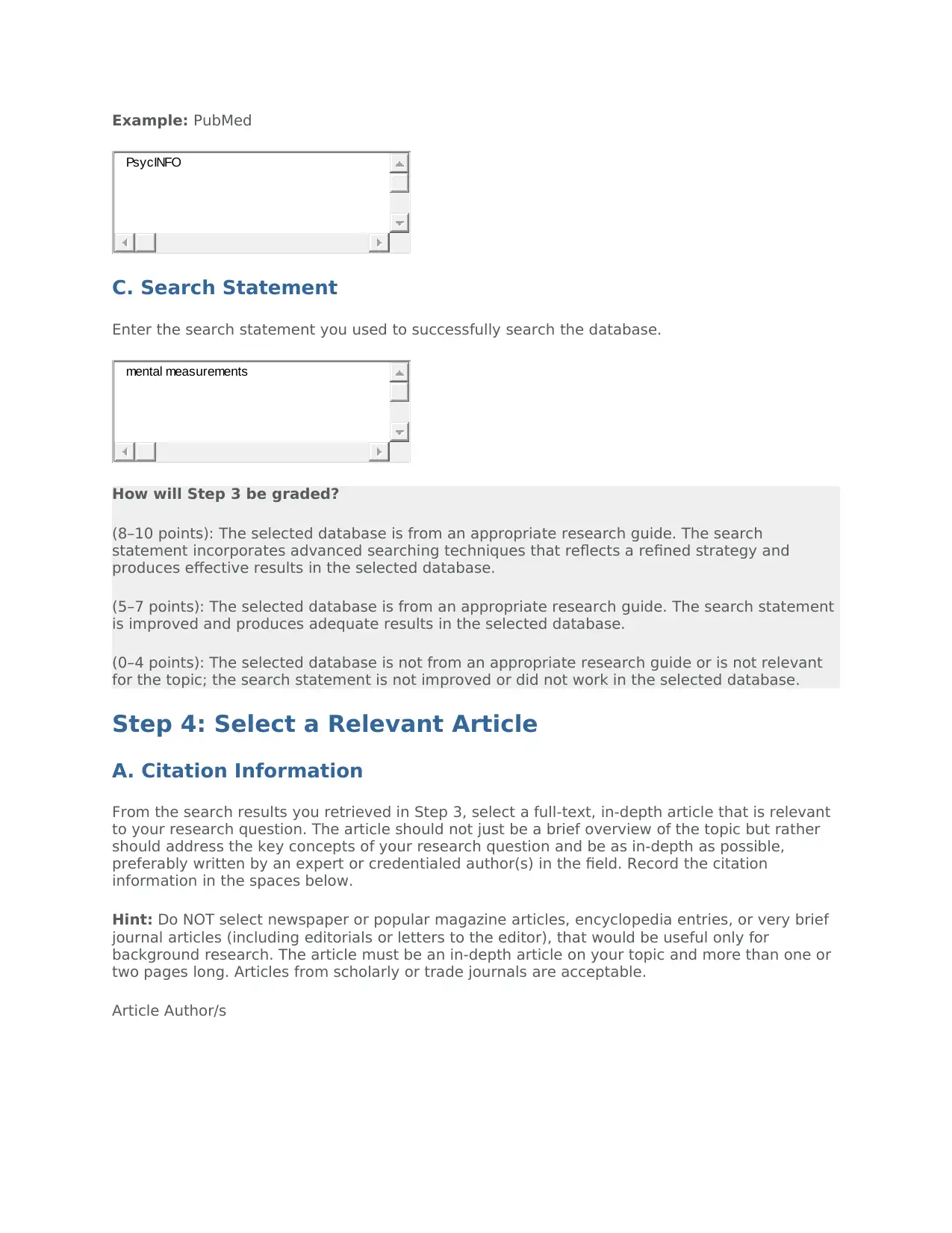
Example: PubMed
C. Search Statement
Enter the search statement you used to successfully search the database.
How will Step 3 be graded?
(8–10 points): The selected database is from an appropriate research guide. The search
statement incorporates advanced searching techniques that reflects a refined strategy and
produces effective results in the selected database.
(5–7 points): The selected database is from an appropriate research guide. The search statement
is improved and produces adequate results in the selected database.
(0–4 points): The selected database is not from an appropriate research guide or is not relevant
for the topic; the search statement is not improved or did not work in the selected database.
Step 4: Select a Relevant Article
A. Citation Information
From the search results you retrieved in Step 3, select a full-text, in-depth article that is relevant
to your research question. The article should not just be a brief overview of the topic but rather
should address the key concepts of your research question and be as in-depth as possible,
preferably written by an expert or credentialed author(s) in the field. Record the citation
information in the spaces below.
Hint: Do NOT select newspaper or popular magazine articles, encyclopedia entries, or very brief
journal articles (including editorials or letters to the editor), that would be useful only for
background research. The article must be an in-depth article on your topic and more than one or
two pages long. Articles from scholarly or trade journals are acceptable.
Article Author/s
PsycINFO
mental measurements
C. Search Statement
Enter the search statement you used to successfully search the database.
How will Step 3 be graded?
(8–10 points): The selected database is from an appropriate research guide. The search
statement incorporates advanced searching techniques that reflects a refined strategy and
produces effective results in the selected database.
(5–7 points): The selected database is from an appropriate research guide. The search statement
is improved and produces adequate results in the selected database.
(0–4 points): The selected database is not from an appropriate research guide or is not relevant
for the topic; the search statement is not improved or did not work in the selected database.
Step 4: Select a Relevant Article
A. Citation Information
From the search results you retrieved in Step 3, select a full-text, in-depth article that is relevant
to your research question. The article should not just be a brief overview of the topic but rather
should address the key concepts of your research question and be as in-depth as possible,
preferably written by an expert or credentialed author(s) in the field. Record the citation
information in the spaces below.
Hint: Do NOT select newspaper or popular magazine articles, encyclopedia entries, or very brief
journal articles (including editorials or letters to the editor), that would be useful only for
background research. The article must be an in-depth article on your topic and more than one or
two pages long. Articles from scholarly or trade journals are acceptable.
Article Author/s
PsycINFO
mental measurements
Paraphrase This Document
Need a fresh take? Get an instant paraphrase of this document with our AI Paraphraser
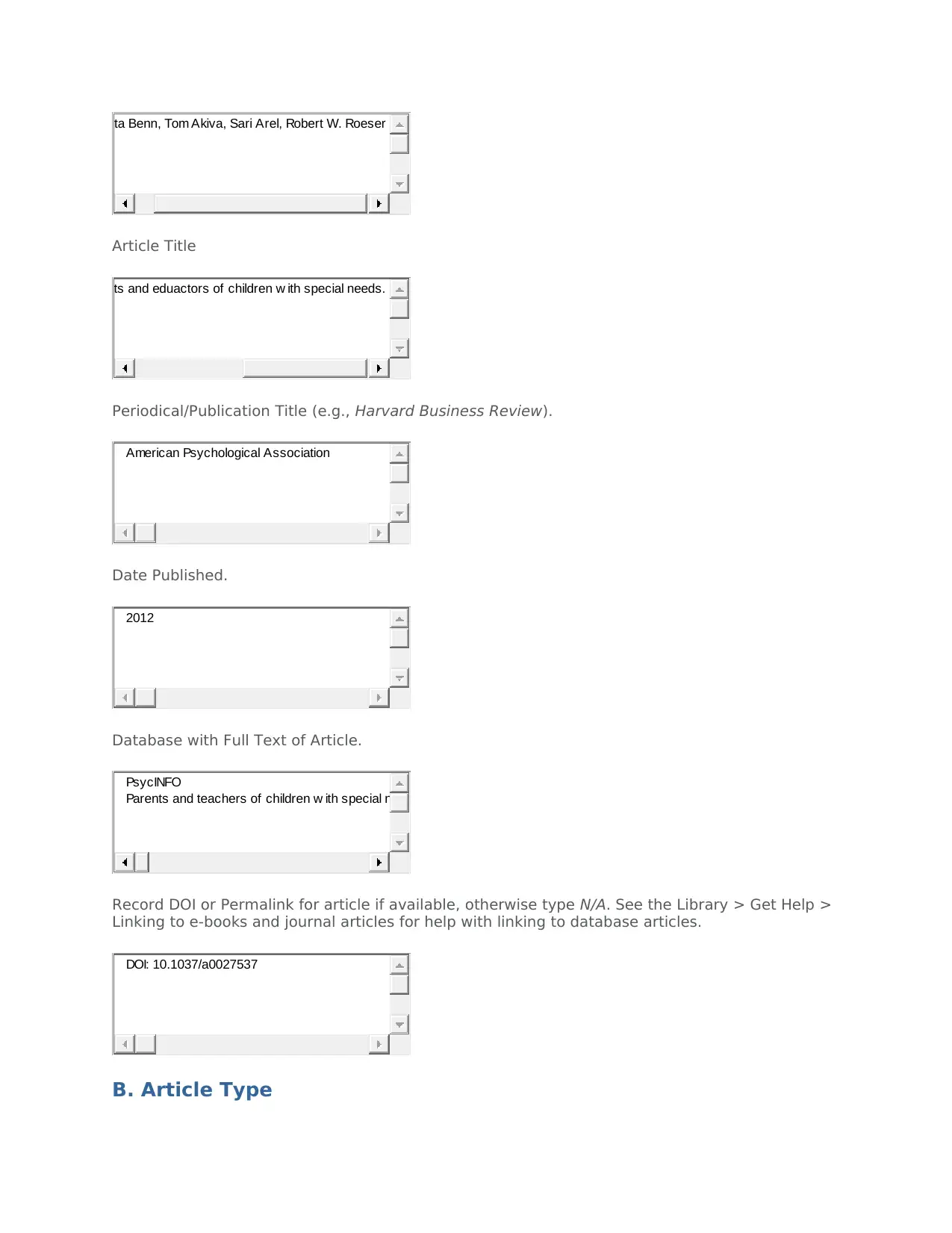
Article Title
Periodical/Publication Title (e.g., Harvard Business Review).
Date Published.
Database with Full Text of Article.
Record DOI or Permalink for article if available, otherwise type N/A. See the Library > Get Help >
Linking to e-books and journal articles for help with linking to database articles.
B. Article Type
Rita Benn, Tom Akiva, Sari Arel, Robert W. Roeser
ing effects for parents and eduactors of children w ith special needs.
American Psychological Association
2012
PsycINFO
Parents and teachers of children w ith special n
DOI: 10.1037/a0027537
Periodical/Publication Title (e.g., Harvard Business Review).
Date Published.
Database with Full Text of Article.
Record DOI or Permalink for article if available, otherwise type N/A. See the Library > Get Help >
Linking to e-books and journal articles for help with linking to database articles.
B. Article Type
Rita Benn, Tom Akiva, Sari Arel, Robert W. Roeser
ing effects for parents and eduactors of children w ith special needs.
American Psychological Association
2012
PsycINFO
Parents and teachers of children w ith special n
DOI: 10.1037/a0027537
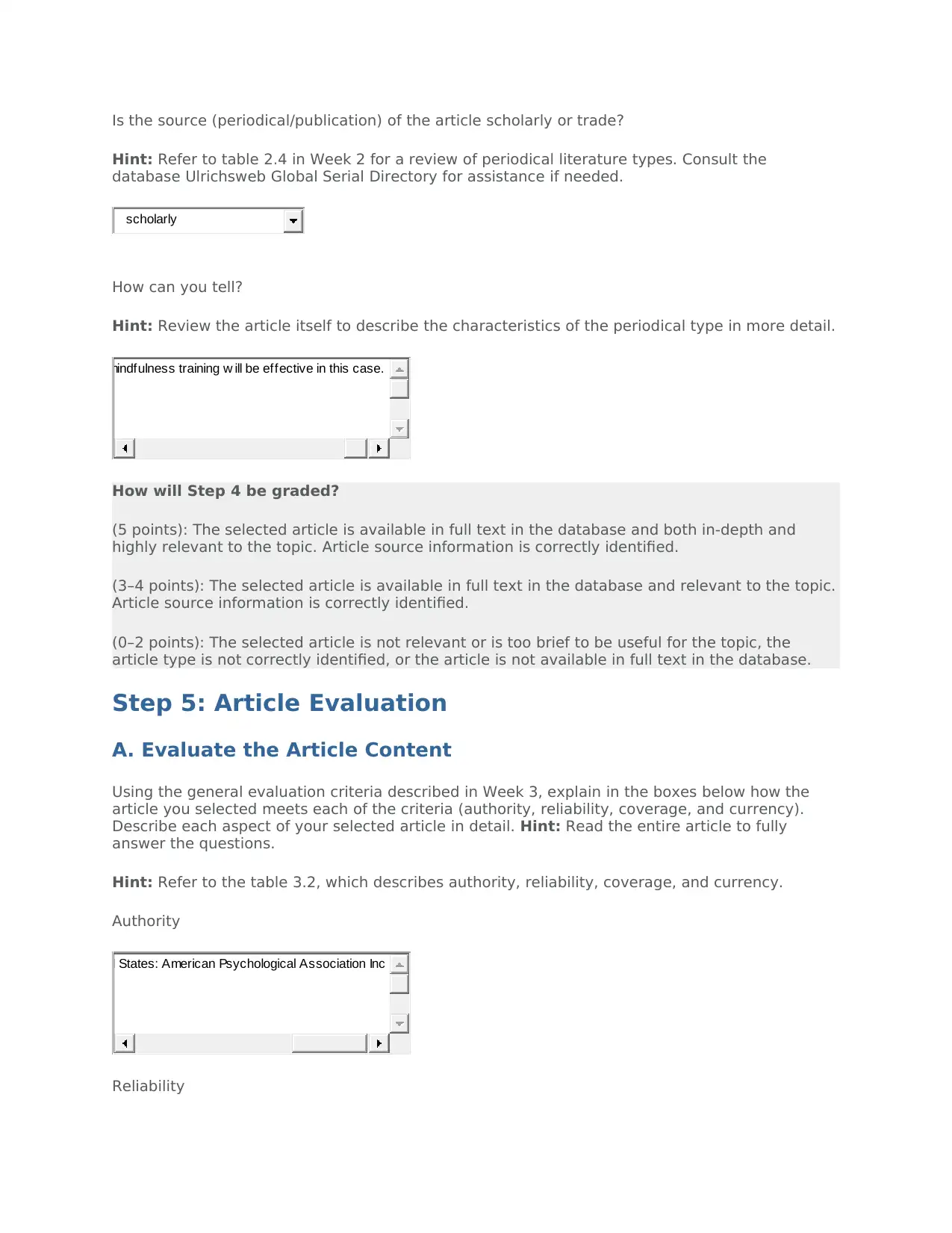
Is the source (periodical/publication) of the article scholarly or trade?
Hint: Refer to table 2.4 in Week 2 for a review of periodical literature types. Consult the
database Ulrichsweb Global Serial Directory for assistance if needed.
How can you tell?
Hint: Review the article itself to describe the characteristics of the periodical type in more detail.
How will Step 4 be graded?
(5 points): The selected article is available in full text in the database and both in-depth and
highly relevant to the topic. Article source information is correctly identified.
(3–4 points): The selected article is available in full text in the database and relevant to the topic.
Article source information is correctly identified.
(0–2 points): The selected article is not relevant or is too brief to be useful for the topic, the
article type is not correctly identified, or the article is not available in full text in the database.
Step 5: Article Evaluation
A. Evaluate the Article Content
Using the general evaluation criteria described in Week 3, explain in the boxes below how the
article you selected meets each of the criteria (authority, reliability, coverage, and currency).
Describe each aspect of your selected article in detail. Hint: Read the entire article to fully
answer the questions.
Hint: Refer to the table 3.2, which describes authority, reliability, coverage, and currency.
Authority
Reliability
scholarly
cusses on w hether mindfulness training w ill be effective in this case.
publisher that is United States: American Psychological Association Inc
Hint: Refer to table 2.4 in Week 2 for a review of periodical literature types. Consult the
database Ulrichsweb Global Serial Directory for assistance if needed.
How can you tell?
Hint: Review the article itself to describe the characteristics of the periodical type in more detail.
How will Step 4 be graded?
(5 points): The selected article is available in full text in the database and both in-depth and
highly relevant to the topic. Article source information is correctly identified.
(3–4 points): The selected article is available in full text in the database and relevant to the topic.
Article source information is correctly identified.
(0–2 points): The selected article is not relevant or is too brief to be useful for the topic, the
article type is not correctly identified, or the article is not available in full text in the database.
Step 5: Article Evaluation
A. Evaluate the Article Content
Using the general evaluation criteria described in Week 3, explain in the boxes below how the
article you selected meets each of the criteria (authority, reliability, coverage, and currency).
Describe each aspect of your selected article in detail. Hint: Read the entire article to fully
answer the questions.
Hint: Refer to the table 3.2, which describes authority, reliability, coverage, and currency.
Authority
Reliability
scholarly
cusses on w hether mindfulness training w ill be effective in this case.
publisher that is United States: American Psychological Association Inc
⊘ This is a preview!⊘
Do you want full access?
Subscribe today to unlock all pages.

Trusted by 1+ million students worldwide
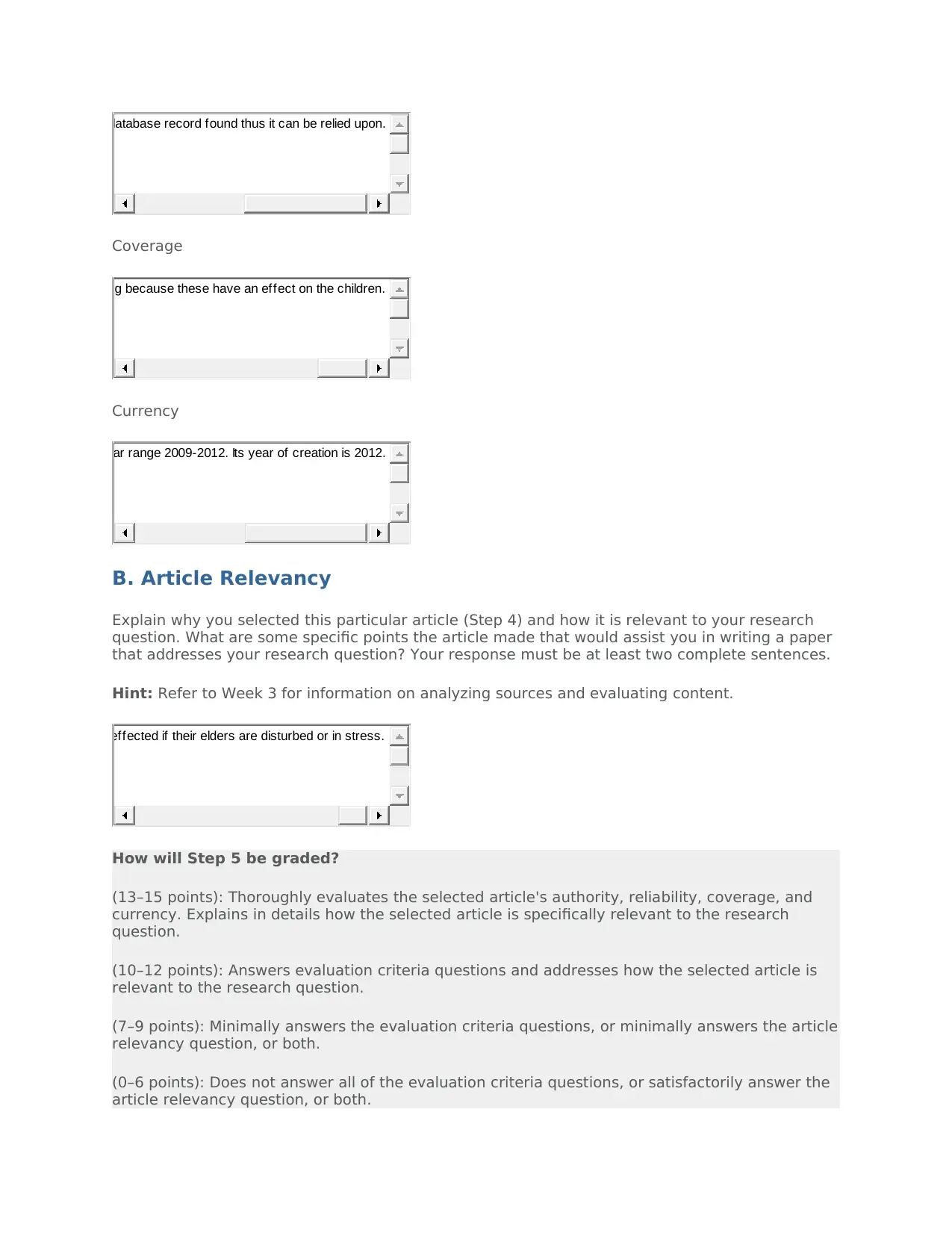
Coverage
Currency
B. Article Relevancy
Explain why you selected this particular article (Step 4) and how it is relevant to your research
question. What are some specific points the article made that would assist you in writing a paper
that addresses your research question? Your response must be at least two complete sentences.
Hint: Refer to Week 3 for information on analyzing sources and evaluating content.
How will Step 5 be graded?
(13–15 points): Thoroughly evaluates the selected article's authority, reliability, coverage, and
currency. Explains in details how the selected article is specifically relevant to the research
question.
(10–12 points): Answers evaluation criteria questions and addresses how the selected article is
relevant to the research question.
(7–9 points): Minimally answers the evaluation criteria questions, or minimally answers the article
relevancy question, or both.
(0–6 points): Does not answer all of the evaluation criteria questions, or satisfactorily answer the
article relevancy question, or both.
ar are provided and database record found thus it can be relied upon.
es mindfulness training because these have an effect on the children.
n published in the year range 2009-2012. Its year of creation is 2012.
and the w ay they get effected if their elders are disturbed or in stress.
Currency
B. Article Relevancy
Explain why you selected this particular article (Step 4) and how it is relevant to your research
question. What are some specific points the article made that would assist you in writing a paper
that addresses your research question? Your response must be at least two complete sentences.
Hint: Refer to Week 3 for information on analyzing sources and evaluating content.
How will Step 5 be graded?
(13–15 points): Thoroughly evaluates the selected article's authority, reliability, coverage, and
currency. Explains in details how the selected article is specifically relevant to the research
question.
(10–12 points): Answers evaluation criteria questions and addresses how the selected article is
relevant to the research question.
(7–9 points): Minimally answers the evaluation criteria questions, or minimally answers the article
relevancy question, or both.
(0–6 points): Does not answer all of the evaluation criteria questions, or satisfactorily answer the
article relevancy question, or both.
ar are provided and database record found thus it can be relied upon.
es mindfulness training because these have an effect on the children.
n published in the year range 2009-2012. Its year of creation is 2012.
and the w ay they get effected if their elders are disturbed or in stress.
Paraphrase This Document
Need a fresh take? Get an instant paraphrase of this document with our AI Paraphraser
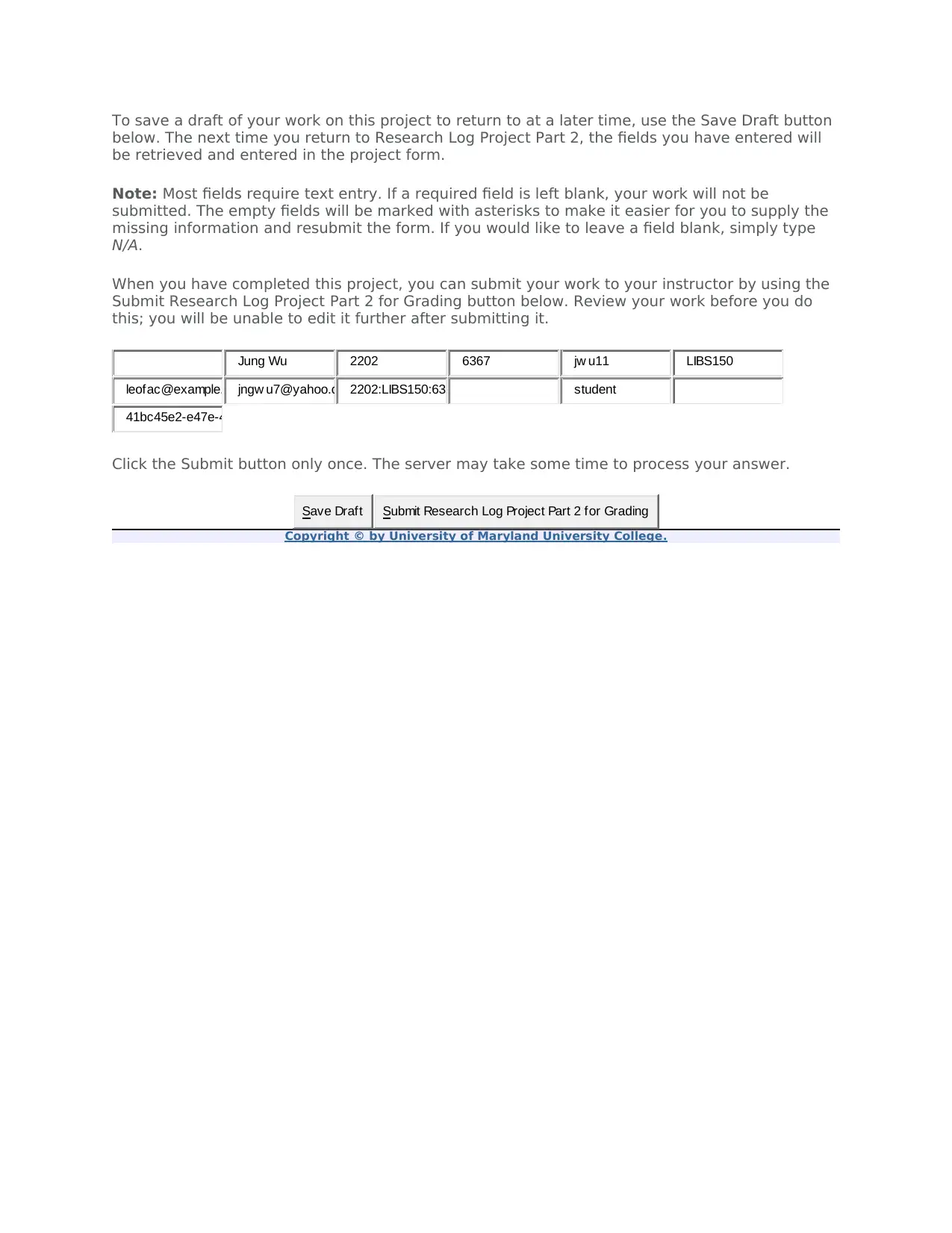
To save a draft of your work on this project to return to at a later time, use the Save Draft button
below. The next time you return to Research Log Project Part 2, the fields you have entered will
be retrieved and entered in the project form.
Note: Most fields require text entry. If a required field is left blank, your work will not be
submitted. The empty fields will be marked with asterisks to make it easier for you to supply the
missing information and resubmit the form. If you would like to leave a field blank, simply type
N/A.
When you have completed this project, you can submit your work to your instructor by using the
Submit Research Log Project Part 2 for Grading button below. Review your work before you do
this; you will be unable to edit it further after submitting it.
Click the Submit button only once. The server may take some time to process your answer.
Copyright © by University of Maryland University College.
Jung Wu 2202 6367 jw u11 LIBS150
leofac@example. jngw u7@yahoo.c 2202:LIBS150:63 student
41bc45e2-e47e-4
Save Draft Submit Research Log Project Part 2 for Grading
below. The next time you return to Research Log Project Part 2, the fields you have entered will
be retrieved and entered in the project form.
Note: Most fields require text entry. If a required field is left blank, your work will not be
submitted. The empty fields will be marked with asterisks to make it easier for you to supply the
missing information and resubmit the form. If you would like to leave a field blank, simply type
N/A.
When you have completed this project, you can submit your work to your instructor by using the
Submit Research Log Project Part 2 for Grading button below. Review your work before you do
this; you will be unable to edit it further after submitting it.
Click the Submit button only once. The server may take some time to process your answer.
Copyright © by University of Maryland University College.
Jung Wu 2202 6367 jw u11 LIBS150
leofac@example. jngw u7@yahoo.c 2202:LIBS150:63 student
41bc45e2-e47e-4
Save Draft Submit Research Log Project Part 2 for Grading
1 out of 8
Related Documents
Your All-in-One AI-Powered Toolkit for Academic Success.
+13062052269
info@desklib.com
Available 24*7 on WhatsApp / Email
![[object Object]](/_next/static/media/star-bottom.7253800d.svg)
Unlock your academic potential
© 2024 | Zucol Services PVT LTD | All rights reserved.




